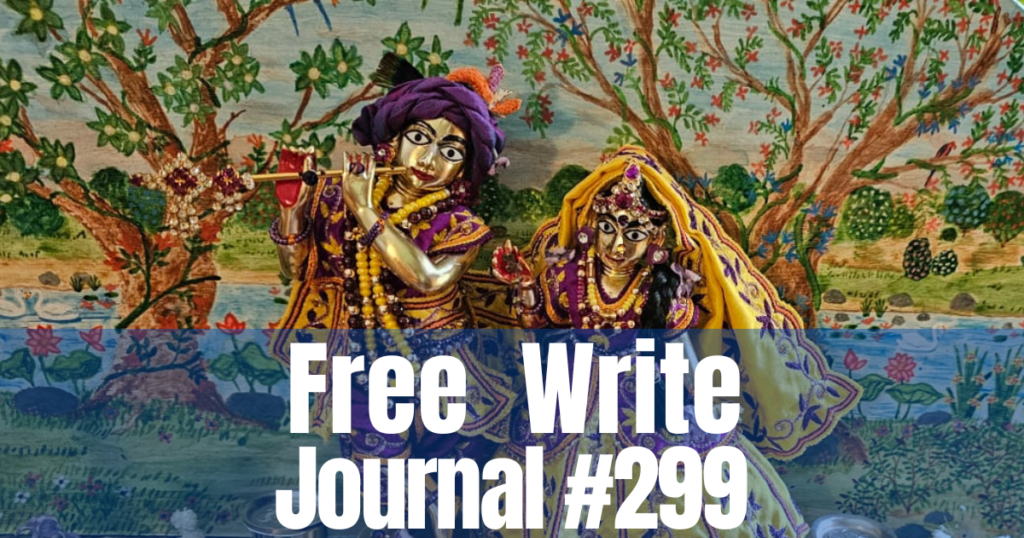
Meeting of Disciples and friends of SDG
The Veterans of Foreign Wars Hall
845 Hudson Avenue
Stuyvesant Falls, New York 12174
There is plenty of parking near the Hall. The facility is just a few minutes’ walk from SDG’s home at 909 Albany Ave.
10:00 – 10:30 A.M. Kirtana
10:30 – 11:00 A.M. Presentation by Satsvarupa Maharaja
11:15 – 12:30 P.M. Book Table
12:30 – 1:15 P.M. Arati and kirtana
1:15 — 2:15 P.M. Prasadam Feast
Baladeva Vidyabhusana at [email protected] or (518) 754-1108
Krsna dasi at [email protected] or (518) 822-7636
SDG: “I request as many devotees as possible to attend so we can feel the family spirit strongly. I become very satisfied when we are all gathered together.”
******
Śrī Caitanya-caritāmṛta, Madhya-līlā 20.124–125: “O great learned devotee, although there are many faults in this material world, there is one good opportunity—the association with devotees. Such association brings about great happiness. . . . .”
Srila Prabhupāda: “Therefore, our Society is association. If we keep good association, then we don’t touch the darkness. What is the association? There is a song, sat-saṅga chāḍi’ kainu asate vilāsa, te-kāraṇe lāgila mora karma-bandha-phāṅsa (Gaurā Pahū, verse 3). Sat-saṅga. Sat-saṅga means association with the devotees. So the one poet, Vaiṣṇava poet, is regretting that, ‘I did not keep association with the devotees, and I wanted to enjoy life with the nondevotees. Therefore I’m being entangled in the fruitive activities.’ Karma bandha phāṅsa. Entanglement.” [Conversation with David Wynne, July 9, 1973, London]
“It was a mixed week for Satsvarupa Maharaja. Most days two or three headaches; some days, none. His anxiety disorder is kicking in about preparations for the summer festival; also, an aspect of the Parkinson’s which brings on broken sleep around the clock has started. This makes it hard on the caretakers who have the night shift. He’ll spontaneously get up for an hour or two to chant or write, then go back to bed.”
Hari Hari,
Baladeva
They are astounded, millions gather around.
They want to walk with Him
but He says, “chant and stay home.”
He’s only one sannyasi,
but He creates huge crowds,
because of His spiritual beauty
and His loud chanting
and His wild dancing.
Who is this person? We have never seen anyone
like Him. Let us follow Him
and give up household life.
“No,” He says, “better
stay home
and chant My holy names.
That way you will never leave Me.”
******
Chant your rounds and read his books. With tachycardia, you don’t have to do much physical exercise; your heart is already pumping at a jogging rate.
******
Desire Krsna. The chanting of His name is recommended. But don’t stay alone in a secluded place and only chant. You’re supposed to go out and speak to people. Sacrifice. This tension will always be present. If you could sincerely call out the Names all day and attentively read the books, I wouldn’t find fault with you. If you could do it with that quality. But even then, the complete recluse life is not recommended.
******
In the morning, Nitai-Gauranga asks me, “What are your plans for today?” I say, “Chanting, writing and reading.” He says, “That sounds good.”
What is good chanting? With attention, alert. I can’t go much further, to love.
******
The day after tomorrow we leave for New Vrndavana. I hope I’ll like mixing with the devotees. There will be lots of them. I hope I’ll even like the plane ride. I’ll be sharing a cabin with Sacinandana Maharaja and Srinandanandana. A certain lack of privacy I’m not used to, but you can endure it. Try to see the good in it. I’m used to chanting my rounds peacefully and slowly, alone. I hope I won’t get disturbed and miss my quota.
******
When chanting on my clicker, I say all of my rounds adequately. I don’t skip one. I say my sixteen rounds, and often say twenty rounds a day. But it’s quite unorthodox in ISKCON, although there are a number of people who do it on the sly. Until the time comes when I can learn how to chant on beads, I’ll have to continue, without shame, my clicker chanting and put my mind and heart into it, although there are many times in public when I can’t do it. At those times, I resort to the beads and to inferior rounds.
******
You just go one chanting sixteen rounds and more. I noticed Narayana-kavaca is very tolerant about his considerable physical maladies. He’s admirable that way. As the years go by, woes pile up. Tolerant fellows roll with the punches and turn to Krsna.
******
Some things have improved. My chanting is more determined. I think I have become more humbled. I am less sharply envious. I accept my reduced position in the institution. I am more patient about getting my books published. I worry less about others’ opinions of me. I believe more in the kindness of my Godbrothers and Godsisters toward me. I have better control over my tongue.
******
Chanting is process. You just do it, and even if it’s shadow chanting, or even offensive chanting (nama-aparadha), you derive tremendous benefit. It’s the only religious sacrifice recommended in the age of Kali. That’s bricklaying. Building your way to the spiritual world.
******
Prabhupada comments that sitting in a solitary place and chanting the Hare Krsna mantra is not for neophyte devotees. They should work hard under the direction of the spiritual master and preach the cult of Sri Caitanya Mahaprabhu. Only after maturing in devotion can one sit down in a solitary place to chant the Hare Krsna mantra, as Lord Caitanya Himself did.
******
The desire to improve one’s chanting and reading in solitude is definitely a very tempting proposition for one like me. But I know I cannot abandon the association of my Godbrothers and at least limited activities of association in the Krsna consciousness movement. What does it mean in the broadest sense to become very mature and thus eligible to spend more time alone? And what happens when the desires for solitary bhajana overwhelms one, even when he is still technically a neophyte? Is it always necessary that he will simply spend his time in sleeping and will fall down? After forty-two years of active traveling and preaching, when one is physically and mentally worn down, can he be considered eligible to spend more time alone?
******
It happens to fortunate persons who expose themselves to chanting the holy names, hearing the scriptures (reading them and hearing them explained by realized souls). Honoring Krsna prasadam helps. Hanging around with disciples of the spiritual master is a very powerful impetus for gaining attraction and faith in Krsna consciousness. These things happened to me, and there’s no real need to analyze how it occurs. Having become fortunate, one should be very careful to protect his good fortune and not fall into misfortune again.
pp. 162-65
As a theologian, Prabhupada very strongly emphasized that Krsna consciousness is known from the sastra. This is brahma-sabda, or revealed truth, and is given directly by Krsna. “The Vedas are directly the Supreme Personality of Godhead, Nārāyaṇa, and are self-born. This we have heard from Yamaraja.” Prabhupada translates “vedo nārāyaṇaḥ sākṣāt” as “directly from the Supreme Personality of Godhead.” (Srimad-Bhagavatam 6.1.40) I once spoke to a professor who said that Krsna consciousness appeared to be a combination of logic and sastra. I asked Prabhupada about this and he replied to me as follows
“Concerning our use of analogy. We do not bring in imperfect analogy, but we follow the instructions of the sastras strictly. Our authority is on the basis of sastra, not analogy … We give analogy for the general mass of people who have not faith in sastra. Analogy is not proof, sastra is proof. Foolish people cannot understand or accept, so we use analogy. The conclusion is not drawn from the analogy but from the sastra. We don’t use a combination of logic and authority, we use authority … The logic of using analogy is called in sastra “sadha chandra nyaya.” It is easier to focus on the moon through the branches of a tree…” (Letter, 75-10-32)
Brahma-sabda is superior to material knowledge, which is subject to the four defects of the conditioned soul. Brahma-śabda (the Vedas) is given directly by the Lord. It is “vedaḥ nārāyaṇah sakṣat: knowledge which is directly the Supreme Personality of Godhead (being spoken by Him).” Therefore, as a Vaisnava theologian, Prabhupada rested all his authority on the Vedas.
Although Srila Prabhupada did not so much discuss the Western theologians, he did criticize the Mayavadis as false theologians who used word jugglery and logic rather than sastra to support their philosophy.
As an acarya, Prabhupada also broke new ground in attacking empirical science. He gave strong arguments against the Western theories of evolution and the origin of life, and he condemned the arrogance of the scientists. Prabhupada strongly asserted that since the scientists were conditioned souls, subject to the tendency to commit mistakes, to be illusioned, to have a cheating propensity, and to rely on their own imperfect senses, “therefore the safe side is to accept the authentic version of Vedic literatures like Srimad Bhagavatam, which is accepted unanimously by the great acaryas.” (Srimad-Bhagavatam 2.2.26) In another purport (Srimad-Bhagavatam 3.9.1) he comments on the illusion of the scientists:
The highest peak of ignorance of the living entities who are conditioned by material bodies is that they are unaware of the Supreme Cause of the cosmic manifestation… . The most stalwart scientists and philosophers cannot be accepted as wonderful. They only appear wonderful because they are the instruments in the hands of the illusory energy of the Lord. Under illusion, the general mass of people deny the existence of the Supreme Lord and accept the foolish products of illusory energy as supreme.
As a theologian, Srila Prabhupada left a legacy for the Bhaktivedanta Institute. In his last days, Prabhupada spoke to Svarupa Damodara: “They have taken God as something mystical. Especially this rascal Darwin’s theory. They have become like animals, and they are seeing everyone as animals… . His theory is taken as the greatest principle of anthropology in the whole world. So scientists by combined meeting should speak out against this Darwin’s theory.” Svarupa Damodara responded, “If we can get some big scientists on our side, at least a few, that will be enough.” “That I am asking,” said Srila Prabhupada.
At this time there was a plan to hold a conference of scientists. Svarupa Damodara suggested that it could be called “Bhaktivedanta Vijnana Conference in Vṛndavana.” Prabhupada objected and said, “They will take it otherwise thinking that Bhaktivedanta is not a jnani. They will take it lightly because Bhaktivedanta Swami is not a scientist.” Prabhupada preferred the title, “Life Comes From Life.” This indicates that he wanted his scientists to do something extraordinary. He would give them the inspiration, but they should use the “bombastic” terminology of the scientists to defeat them. (Srila Prabhupada-lilamrta)
The summation of Srila Prabhupada’s approach to theology rests in his name: Bhaktivedanta. He stated that religion without philosophy was fanaticism, whereas philosophy without religion was dry, mental speculation. But religion and philosophy have their union in Vedanta, “the end of knowledge.” Bhakti is the natural inclination of the soul to God:
Simply by giving aural reception to this Vedic literature, the feeling for loving devotional service to Lord Krsna, the Supreme Personality of Godhead, sprouts up at once to extinguish the fire of lamentation, illusion and fearfulness. (Srimad-Bhagavatam 1.7.7)
One may ask, “If Prabhupada did not count on the logical proofs for God’s existence as much as sastra, and if his proofs were presented in a simple manner, and if these theistic proofs are subject to so much logical criticism, how shall we regard them and use them?” We may use the proofs as Srila Prabhupada used them. Most people will accept them, and if we meet a sophisticated, skeptical challenge, we can be aware of the shortcomings in the logical proofs. Srila Prabhupada did not use these arguments as absolute proof, but as tools in preaching. As the opponents of the classical proofs have pointed out, lovers of God will not need these arguments.
pp. 25-27
The house is approximately one-half kilometer south of the Simha-dvara gate. Turning right to Sweta-ganga tank, Sarva-bhauma’s house is on the left.
It seems to be a somewhat hidden place, not indicated in any of the tourist books and neither is it a busy ashram. It is more like a household. The residents seemed friendly and showed us into a small open hall with an enclosed structure at one end. The man indicated a corner and said that this was the spot where Sarvabhauma Bhattacarya discoursed on the Vedanta for seven days and Lord Caitanya defeated him with the Vaisnava siddhanta.
The area is about twelve feet by twenty-four feet, with a black floor. The plaster walls have been painted with many different devotional scenes. One wall in the corner shows Sarvabhauma Bhattacarya, quite a stout figure, with sikha and short beard. He is sitting with his left hand on his hip, his right hand gesturing with fingers downward, as he debates. Worshipers fan him with camaras. On the wall facing Sarvabhauma Bhattacarya at an angle is a three-quarter bas-relief of the Sadbhuja of Lord Caitanya. Below Lord Caitanya are a table and black wooden sandals. The caretaker said these sandals belonged to Sarvabhauma. Other frescos in the room are fading, such as the ones of two bulls (or cows) butting heads; a four-armed form of Nrsimhadeva; a large painting of Jagannath Deities; a baby Krsna; and near the ceiling, a series of about twenty-five separate scenes of krsna-lila soon to fade away unless they are repainted.
One would like to question the residents more about some of the intricate points, such as whether this was actually the spot where the Vedanta was spoken, or was it spoken in Jagannath temple, as it appears to say in Caitanya-caritamrta. One would like to ask: Where did Sarvabhauma bring Lord Caitanya when he found Him unconscious in the temple? Where is the place where Lord Caitanya gave the Jagannath prasad to Sarvabhauma early in the morning? Where are the rooms, as they are described in such a detailed way, where Caitanya Mahaprabhu feasted, on the invitation of Sarvabhauma and his wife? And since they have consecrated this spot as the site of the seven-day discussion on the Vedanta, one wants to meditate on that philosophical exchange and the triumph of Lord Caitanya. But the family who lives here does not speak our language, and while we try to meditate, they are speaking of other things. (According to Narada Rsi, their talk was not so friendly. It was the same Puri line: that the Westerners are not allowed in the temple because they are low-class, don’t follow sanatana-dharma, are mlecchas, and so on. There seems to be very little acquaintance with the actual practices of ISKCON devotees or even a theoretical comprehension of the knowledge that even a dog-eater can become transformed into a Vaisnava by the chanting of the holy name.)
I promised myself that I will reread Srila Prabhupada’s purports and the verses in Madhya-lila, Chapter Six. Certainly this spot is special because it is Sarvabhauma Bhattacarya’s house and has the paintings of Sadbhuj and Saravabhauma and because the residents have the sense to commemorate the occasion of the Vedanta explanation by Sri Caitanya Mahaprabhu.
Other items in the hall: a separate bas-relief of Krsna lifting Govardhan Hill; in a niche, half-covered with cloth, a painting of Sarvabhauma, with his hand in a teaching mudra, and his followers—two ladies and ten men with tilak, sikhas, and folded palms—all standing and facing Sarvabhauma in a worshipful pose. There is also a painting of Maharaja Prataparudra standing with folded palms, facing Lord Caitanya, and another of Sarvabhauma, who appears to be worshiping Lord Caitanya.
A young boy of the house took an interest in us and showed us something special: a hidden tunnel which they claim leads in two directions—to the sea and to the Jagannath temple. Supposedly it was used by Lord Caitanya.
Opposite this hall there is a Deity room where there are Radha-Krsna Deities, Radha-Rasikaraja and four other sets that they say were worshiped by Sarvabhauma Bhattacarya. Their worship continues today, and we saw Them with. Their winter coverings.
pp. 149-50
Japa isn’t moving beads like a Chinese launderer moving his abacus to figure out your bill. It is calling to Krsna. Don’t forget the gopis talking to one another, Hare Krsna Hare Krsna . . . Don’t forget Krsna, the best of dancers entering the forest, beautifying the land with the marks of His feet. Hare Rama . . . He has placed blue karnikara flowers over His ears … Rama Rama . the gopis are speaking to each other privately . . . Don’t be mechanical.
Hanging out in the hallway. We have a well-used rattan chair, trimmed with worn-down bicycle tires inscribed “Heavy duty tyre.” I put it in the outdoor hall which faces the front gate. I can sit there and write when I am not at my desk. Does this imply that my work isn’t serious?
I have lost my concentration on this writing retreat, so we have decided to cut back extra activities like Srimad-Bhagavatam classes and lunch with Godbrothers for the next two weeks. Also, devotees are handing me letters and I have been replying immediately.
I seem to have weathered the blast from my param-guru, Bhaktisiddhanta Sarasvati, who wrote that the dhama isn’t worshipable unless we are completely surrendered to the guru and receive the dhama’s teachings from him. I gave Bhaktisiddhanta Sarasvati’s essay to Baladeva, because he may have been naive in his affection for all the people moving through Vrndavana.
He wrote me back:
“It was good for me to read that article, but still there seems to be a lot of things that are wonderful here like the different kind of kirtanas:kirtana procession before a dead body heading for the Yamuna; kirtana led by a well-dressed swami, broadcast over a loudspeaker. Dancers following him, all chanting “Govinda jaya jaya” right through the center of town. It stopped traffic for forty minutes, but no one was annoyed. A large three-wheeler filled with devotees’ going somewhere and chanting Hare Krsna kirtana in a tune familiar in our temples; widows at an asrama chanting Hare Krsna while waiting for breakfast to be served.
“If you go to the shops early, you can see that most shopkeepers are just coming from a temple . . . . They are definitely in a more devotional mood than later in the day . . . Bead bags, clean clothes, nice kumkum on their foreheads, quoting verses, etc.”
The Indian squirrel is shy, and yet he comes forward in his own way, much bolder than an American squirrel. (They are actually gray chipmunks. It is said that they got the stripes on their backs when Lord Ramacandra petted them after they attempted to help Him build the bridge of stones to Lanka.) As I write, one squirrel has climbed in the garbage bucket and come out with a morsel of food. He is eating with two hands, quickly finishing it and looking for more.
On the low brick wall, there is a bird with a pointy head and black and white wings which he is fluffing and preening. So many things are difficult to do in India, including finding out the names of the birds. Someone will tell me a Hindi name, but still I can’t get it. I keep using my own names: small-green-bird-on-electric wire, sparrows, bold-fluffy-white birds. So many varieties in Vrndavana!
The flies make my hallway chair not so congenial, but I am too happy to be in Vrndavana to mind much.
Gave the Srimad-Bhagavatam class. One Indian man from Singapore approached me afterwards and thanked me. Otherwise, it is the usual scenario—I become enthusiastic about what I said, wonder how it affected others, but no one says anything. Then I realize that my class was a routine Srimad-Bhagavatam class, and even the best things I said were good not because I said them, but because they are the eternal teachings of Krsna consciousness. I did my bit.
pp. 135-37
(noun) from the French, votum; see VOTE.
“1. a solemn promise or pledge, especially one made to God or to a god, dedicating oneself to an act, service, or way of life. 2. a solemn promise of love and fidelity [marriage vows]. 3. a solemn affirmation or assertion. To praise, to promise solemnly. To make a vow, to take vows, make the vows required for formal entrance into a religious order or community.”
We take initiation vows into Krsna consciousness. Perhaps it doesn’t sound as weighty as the vows required of candidates seeking entrance into a religious order or community, at least in the Christian sense, but it is. For example, out of millions of Catholics, how many actually take vows? Very few. Only those who become priests, monks, or nuns.
A vow is meant to be upheld for an entire lifetime. It’s not unusual that devotees (and Catholics) reconsider their vows after some years have passed. Often, they decide the vows are no longer relevant to their lives.
Recently, an initiated disciple wrote me to explain why he planned to no longer follow his initiation vows. He said he saw it as a positive step forward in his life, and indirectly he criticized Prabhupada and the whole process of becoming bound by vows. He said that he has been studying psychology and that psychology teaches that only a rare person can sublimate sex desire and avoid all illicit sex throughout his life. Therefore, we shouldn’t look upon illicit sex as some dragon to be conquered. It’s natural. Similarly, he no longer wanted to chant sixteen rounds. He said vows make us neurotic because when we cannot follow them due to the circumstances in our lives, we feel guilty. Better to chant a little bit and read on occasion and just balance life as we see best. The pressure of the vow is too much.
I found his reasons feasible enough, but what’s that got to do with the integrity of the vow? It’s not my job to revise other people’s vows. A vow is not something we argue about or readjust. Just imagine the chaos that would result if the leaders of a world religion conferred and wrote papers to revise the nature of people’s commitment to their religion. They would only do so after a tremendous ground swell from the religion’s adherents who were demanding reform. Prabhupada would never allow us to declare that it was no longer necessary to follow the four regulative principles or to chant sixteen rounds.
In the absence of a higher authority releasing us from our vows, we have to take the responsibility on ourselves to follow them or not. I cannot condone the breaking of vows. Even the dictionary, mundane as it is, calls it a solemn pledge and admits that such pledges are often made in service to God.
If we lack the strength to follow our vows, we should pray to Krsna. He is the source of all strength. Nayam atma pravacanena labhyo: only by Lord Balarama’s mercy can we follow our vows. Balarama’s potency comes through the spiritual master.
Our particular vows are not so difficult to practice. We don’t have to be proud that we maintain them. They are only the standard of civilized human behavior. They’re not so extraordinary. It’s not only saints who can sublimate their sex desire. Anyone can do it by guru and Krsna’s grace. Rather than want to give up our vows, we should thank Prabhupada and Krsna for these regulative principles of freedom.
Rasa-sthali: the rasa dance took place here. Anyone want to say anything?
“Could you tell us the difference between the priya-sakhi gopis, the prana-sakhi gopis, and the nitya-siddha gopis? I would particularly like to hear how they shed both prarabdha- and aprarabda-karma when they heard Krsna’s flute. At what point did they attain siddha-deha?”
I’d rather not get into that just now.
Dear trees of Rasa-sthali—then the mind goes off, right in mid-prayer, even within the course of a moment while I lie at the base of a tree. At least I made a physical connection with the earth at this place. I bent to the tree root, I felt the tree’s rough bark. The thought derails me, then returns, and I pick it up in my hand the way I used to control my Lionel model trains as a boy. Turning on the transformer—volume up, the train veers around the bend and the black locomotive crashes to the side, its pill-produced smoke billowing.
Dear trees . . . I
want to control my mind
my tongue
my words
my anger, belly,
genitals, legs,
toes. Just
give me your blessings
to transcend my cultural conditioning.
Nama om Visnu-padaya krsna-presthaya bhu-tale srimate bhaktivedanta-svamin iti namine. Just that, just that, that’s all.
Does it really matter that we can’t control the mind? Are we expected to do it at every moment? Don’t try for the impossible. As Dom Chapman, a Benedictine spiritual director of the early 1900s said, “Pray as you can, not as you can’t!”
I’m not talking about the failure to be one hundred percent perfect. I’m talking about feeling like a dead leaf, dragging your carcass from kunda to kunda with nothing. Even that is all right, I guess. It’s certainly humbling. I just want to admit it, at least to myself.
It sure is cold out today. Every time I say something, frost issues from my mouth along with my words. Indigestion from too much cereal. Srila Prabhupada said that during the famine in India in the 1940s, people didn’t die of starvation but of overeating once they received food. He quoted statistics that stated that heart failure caused the most deaths in the U.S.A. and that overeating was the second biggest cause. His point was, “Don’t eat too much or too little. Eat just enough to keep body and soul together.” I don’t consider this thought off the point of parikrama. Anytime I can remember what he said, it is good.
The trees at Rasa-sthali are not ordinary, like the fir trees covered in old snow that I see here. The trees at Rasa-sthali are old—thousands of years old. I want to touch them with reverence again.
I have a favorite tree in Raman Reti. I go there and prostrate myself at its roots and pray. What do I pray for? Mostly I just recite exalted sentiments, even though I don’t feel them: “Please bless me to attain devotion to my spiritual master and to his mission in this world. Please allow me to know who he is so I can serve him eternally.” Stuff like that. Prayers made at the roots of old trees.
pp. 184-
We thought that Prabhupada
would spend the rest of his life in America.
And that was his mood.
But in the summer of ’70,
when the L.A. center was burgeoning
and unfortunate signs appeared
of a too-familiar attitude toward him,
he left with a few sannyasi disciples
and informed us that India
was his next important field.
When Prabhupada went to India,
I was in Boston.
We didn’t know if we would ever go,
but like his other followers,
we were swept up to hear it.
First letters came from his servant,
and some photos.
We heard from the devotees how India
was harsh and very exotic.
One devotee wrote that other Indians
looked and even gestured somewhat like Prabhupada
but that no one was genuinely like him.
Probably in all of India
there was no pure devotee like him.
And then letters came from Calcutta and Bombay,
exclamations of how even the disciples
were being honored and were staying at rich men’s homes,
and some of them were getting sick.
Prabhupada, they said, was preaching like a lion.
He was different in India, they said,
and he lived more simply.
In L.A. he accepted a suite of rooms,
and rode in an American car,
but in India, where such things weren’t available,
he lived like a simple sadhu.
Mosquitoes didn’t seem to affect him,
nor did the heat, power failures, and delays.
He was relaxed and more at home.
He even dressed differently.
He still wore the dhoti,
but now he had no need for sweaters
or socks or hats or coats.
Usually he wore no shirt but just a top cloth
and sometimes sat bare-chested,
drinking water from a lota.
When he arrived in Calcutta,
reporters and elderly friends,
afraid of the Naxalite terrorists,
asked for political solutions.
But he said, just chant Hare Krsna,
the actual panacea—
if people will take to it.
He sent his few men out to chant
in the heat of Dalhousie Square.
Their kirtan was a sensation.
But Prabhupada, thinking it might be misunderstood,
introduced Life Membership,
a form of preaching
where a gentleman will pay
for Krsna conscious books and guest privileges
at ISKCON temples around the world.
He asked that we also try it in America,
but it didn’t work as well.
The Indians were pious
and Prabhupada was personally
conducting that campaign.
Devotees in India also told us
the most wonderful thing of all,
which made India worth the trouble:
Prabhupada was much more available there.
He would keep the door to his room open,
and at any time they could come.
He formed more personal ties,
and even the women got to talk to him.
The devotees with Prabhupada in India
got to see another side of him.
He would sympathize that they had no milk,
that the weather was hot,
and their stomachs upset,
and he encouraged them that a year in India was worth
ten years’ service in the West.
And he told them his strategy . . .
Due to Mogul and British domination,
Indians had grown ashamed of their culture.
The intelligentsia had come to accept
their religion as backward—
they should imitate the West,
with its money, technology, happiness, and success.
So Prabhupada thought if the Westerners
came to India and showed
that they preferred to be Vaisnavas,
that they were not happy
being rich and hedonistic and had given it up
to serve Lord Krsna,
then the Indians might
wake up and stop their madness
of the blind leading the blind.
Another wonder from India
was the massive pandal programs,
meetings in open tents,
where ten or twenty thousand would gather
to hear Prabhupada and Hare Krsna kirtan.
They would rush forward for a piece of prasad;
or to touch his holy feet.
Nothing like this was in the West
And Prabhupada would strongly preach,
denouncing bogus gurus. false saints,
ignorant politicians, Mayavadis—
anyone opposed to Krsna.
This is the land of Krsna, he told them.
Why are you rejecting Him?
Why are you changing
the direct meaning of the Gita?
Why are you wasting your human form of life?
Then the “foreign devotees” would hold kirtan,
and the people marveled to see
dancing white elephants.
In Boston through letters we heard
that Prabhupada was easily able to meet
with national leaders and the biggest businessmen,
like Mrs. Gandhi and the Birlas.
He was respected. considered a leader
for his work in the West,
for his books. and for a saintliness
no one could deny.
In India Prabhupada was also
more involved in managing ISKCON.
The devotees were like babes in the woods
in dealing with Indian merchants.
Prabhupada called his boys, “Damn cheap babus,”
a name Indians used for a Westerner
who pays five times the normal price
but is convinced he bought it “damn cheap.”
Taking control, Prabhupada showed them
how to keep accounts,
how to deal with the ricksha-walla,
murti-walla, karatal-walla.
the dobhi. the mistri, the bhangi,
bank clerk, government clerk,
barrister, policeman, rich man.
How Not To Be Cheated was one of the most
important and difficult lessons he taught.
He was expert at it,
but he thought it might not be possible
for his students to thoroughly learn.
And when people in India criticized
the Hare Krsna members,
calling them sporadic faddists,
or saying that the white men had no right
to become brahmanas or sannyasis,
Prabhupada staked his reputation
defending the Western Vaisnavas.
All the sastras supported him
attesting that one from any birth
could become a brahmana
provided he associate with a pure devotee
and take up Vaisnava habits.
And when his students’ conduct
was below the standard of a Vaisnava,
when they ate too much in public,
or used the wrong hand,
or insulted a ricksha-walla,
or fought among themselves
and it didn’t look so great—
still he defended them and said:
In any case they are chanting Hare Krsna.
They have long been accustomed
to fallen ways, but surely
they will improve. As Krsna says,
Api cet sudaracaro.
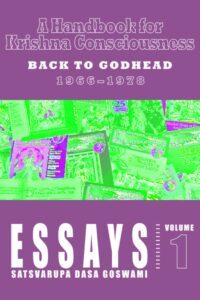
This collection of Satsvarūpa dāsa Goswami’s writings is comprised of essays that were originally published in Back to Godhead magazine between 1966 and 1978, and compiled in 1979 by Gita Nagari Press as the volume A Handbook for Kṛṣṇa Consciousness.
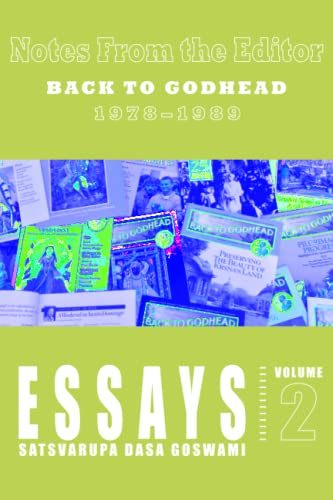
This second volume of Satsvarūpa dāsa Goswami’s Back to Godhead essays encompasses the last 11 years of his 20-year tenure as Editor-in-Chief of Back to Godhead magazine. The essays in this book consist mostly of SDG’s ‘Notes from the Editor’ column, which was typically featured towards the end of each issue starting in 1978 and running until Mahārāja retired from his duties as editor in 1989.
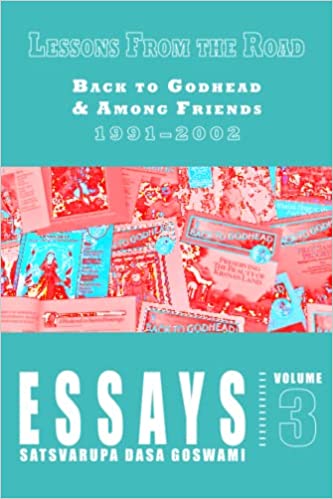
This collection of Satsvarupa dasa Goswami’s writings is comprised of essays that were originally published in Back to Godhead magazine between 1991 and 2002, picking up where Volume 2 leaves off. The volume is supplemented by essays about devotional service from issues of Satsvarupa dasa Goswami’s magazine, Among Friends, published in the 1990s.

“This is a different kind of book, written in my old age, observing Kṛṣṇa consciousness and assessing myself. I believe it fits under the category of ‘Literature in pursuance of the Vedic version.’ It is autobiography, from a Western-raised man, who has been transformed into a devotee of Kṛṣṇa by Śrīla Prabhupāda.”
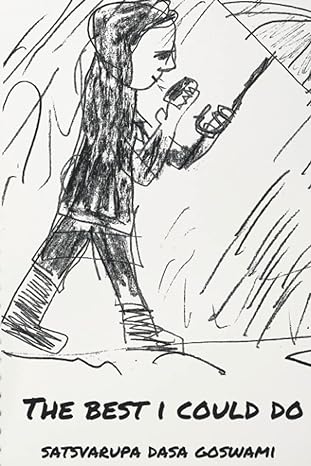 The Best I Could Do
The Best I Could DoI want to study this evolution of my art, my writing. I want to see what changed from the book In Search of the Grand Metaphor to the next book, The Last Days of the Year.
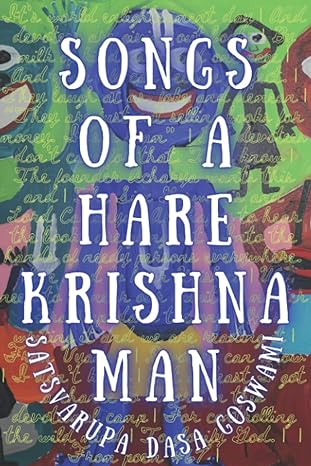 a Hare Krishna Man
a Hare Krishna ManIt’s world enlightenment day
And devotees are giving out books
By milk of kindness, read one page
And your life can become perfect.
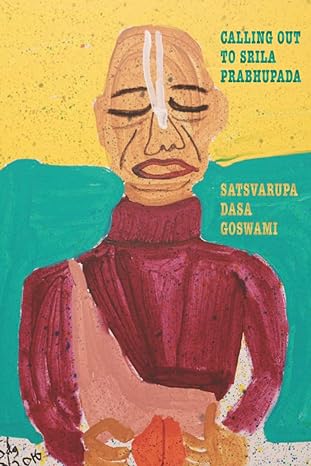 Calling Out to Srila Prabhupada: Poems and Prayers
Calling Out to Srila Prabhupada: Poems and PrayersO Prabhupāda, whose purports are wonderfully clear, having been gathered from what was taught by the previous ācāryas and made all new; O Prabhupāda, who is always sober to expose the material illusion and blissful in knowledge of Kṛṣṇa, may we carefully read your Bhaktivedanta purports.
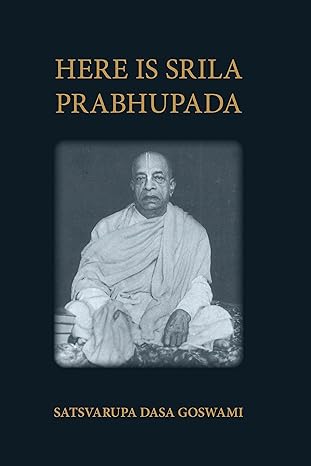
I use free-writing in my devotional service as part of my sādhana. It is a way for me to enter those realms of myself where only honesty matters; free-writing enables me to reach deeper levels of realization by my repeated attempt to “tell the truth quickly.” Free-writing takes me past polished prose. It takes me past literary effect. It takes me past the need to present something and allows me to just get down and say it. From the viewpoint of a writer, this dropping of all pretense is desirable.
 Geaglum Free Write
Geaglum Free WriteThis edition of Satsvarūpa dāsa Goswami’s 1996 timed book, Geaglum Free Write Diary, is published as part of a legacy project to restore Satsvarūpa Mahārāja’s writings to ‘in print’ status and make them globally available for current and future readers.